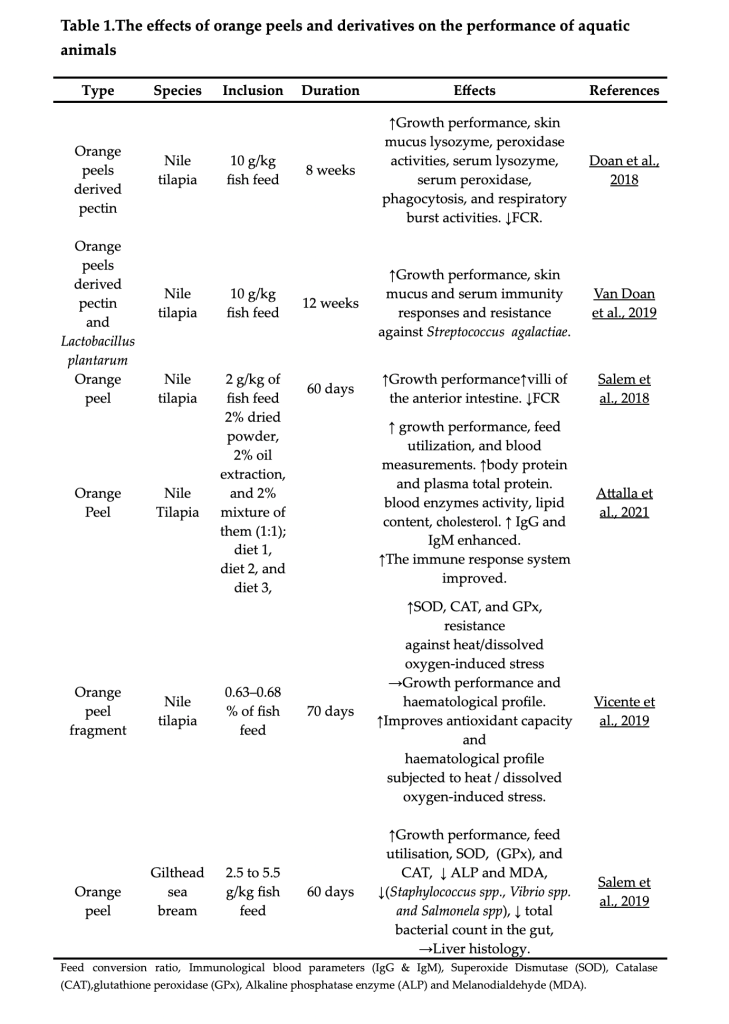Aquaculture is a rapidly growing industry that plays a crucial role in meeting the increasing global demand for seafood. One of the key challenges in aquaculture is to develop sustainable and cost-effective methods to enhance fish growth, health, and overall productivity. In recent years, researchers and aquaculturists have turned to unconventional and eco-friendly feed additives, and one such promising option is the use of orange peel and its derivatives. Orange peel, a byproduct of the citrus industry, is rich in bioactive compounds, making it a potential candidate for improving various aspects of fish farming.
Sweet orange, scientifically known as Citrus sinensis, is one of the most extensively cultivated and consumed citrus fruits globally. These oranges are distinguished by their unique flavor, taste, and aroma, and they are renowned for their richness in vitamins and minerals, including vitamin C, folic acid, carotenoids, potassium, pectin, and dietary fiber. Citrus fruits, including sweet oranges, also contain bioactive components like polyphenolic compounds such as phenolic acid and flavonoids, which provide them with antioxidant, anti-inflammatory, and antibacterial properties (Guimarães et al., 2009).
Orange by-products
Orange by-products refer to the solid residues that remain after the extraction of juice from oranges. These residual materials encompass the peel, pulp, rag and seeds. The yield of orange juice and the chemical composition of citrus by-products depend on factors such as the method of juice extraction, the type of citrus fruit, climatic conditions, cultivation location, and the amount of residual water remaining after processing. These orange by-products make up approximately 50% to 70% of the total weight of citrus fruit processing. Specifically, orange by-products consist of approximately 60% peel, 30% pith residues, and 10% seeds (Chavan et al., 2018).
These by-products are characterized by their high moisture content, typically around 85%, and organic matter. Furthermore, they serve as a valuable natural source of essential compounds, including carbohydrates like cellulose, starch, pectin, and dietary fibers, as well as proteins, organic acids such as citric, malic, and oxalic acids, lipids including linolenic, oleic, palmitic, and stearic acids, essential oils like d-limonene, α-terpinolene, and α-pinene, carotenoids such as carotene and lutein, vitamins including vitamin C and vitamin B complexes, and polyphenols, encompassing flavonoids and phenolic acids (Mahato et al., 2018).
Bioactive compounds in orange by-products:
1. Pectins
Pectin is a gel-like polysaccharide with a high molecular weight found in the cell walls and middle lamella of citrus plants. It provides strength and flexibility to plant cells and is composed of a linear chain of d-galacturonic acid units linked together by α-1,4 glycosidic linkages. These linkages are partially esterified with methanol or acetic acid to produce methyl esters. Orange by-products contain a notable proportion of pectin, ranging from 20% to 30% of the overall dry weight of the peels, which is higher than that found in apple by-products (10%–15%) (Satari et al., 2017). Within orange by-products, there exist two categories of pectins: insoluble pectins and soluble pectins, with colors spanning from white to a light brown hue. Pectins find application in the food industry, serving various functions such as thickening, emulsifying, texturizing, stabilizing, and even as a replacement for fats (Satari et al., 2017).
2. Phenolic compounds
Citrus by-products exhibit higher levels of polyphenols, ranging from 0.67% to 19.62% on a dry basis, when compared to the edible parts of the fruit (M’hiri et al., 2017). The primary flavanones found in orange peels include neoeriocitrin, naringin, and neohesperidin. The most abundant polyphenols within the orange peels, known as the flavedo, are flavonoids. These comprise four groups: flavanones in substantial quantities, followed by flavones (e.g., luteolin, apigenin, and diosmin), flavonols, isoflavones, flavanols, and anthocyanins. Dry citrus peels contain approximately 2% to 3% flavanones and 0.91% to 4.92% of total polyphenols. The orange peels also contain phenolic acids, including hydroxybenzoic (e.g., gallic, vanillic, and syringic acids) and hydroxycinnamic acids (such as caffeic, ferulic, p-coumaric, and sinapic acids). These compounds possess potent antioxidant effects, acting as scavengers of free radicals and chelating agents for heavy metals. Orange by-products in powdered form have been employed as natural antioxidants (Benamrouchea & Madania, 2013).
3. Dietary Fibers
Orange fruits are abundant in both soluble dietary fibers (SDF) and insoluble dietary fibers (IDF), primarily concentrated within the peel. SDF encompasses substances like gums, pectins, glucans, and various biological and synthetic polysaccharides, while IDF includes cellulose, hemicellulose, and lignin. Citrus waste fibers are characterized by their high nutritional value, balanced composition, and notable content of SDF and bioactive elements, including flavonoids and carotenoids. For orange peels, the fiber content is approximately 57 g per 100 g of dry matter (Fishman et al., 1999). Cellulose and hemicellulose contents in citrus peels can range from 50% to 60%. Pectins, lignins, celluloses, and hemicelluloses in orange peels exhibit the following ranges: 13.00–23.03 g/100 g dry matter, 7.52–7.56 g/100 g dry matter, 23.06–37.08 g/100 g dry matter, and 8.09–11.04 g/100 g dry matter, respectively (Marín et al., 2007). Citrus fibers, comprising polysaccharides and polyphenol-like components, possess antioxidant properties that inhibit lipid oxidation in meat products, maintain oxidative stability, and extend the shelf life of meats.
Effects of orange peel and mycotoxins mitigation on fish
Citrus by-products are commonly employed as animal feed to prevent environmental accumulation. In aquafeeds, researchers have explored the use of citrus fruit by-products as functional supplements, which has consistently resulted in enhanced growth and health performance in various aquatic animals (Table 1). For instance, a study by Salem et al. (2019) revealed that gilthead seabream experienced improved growth performance when orange peel was included in their diets at concentrations ranging from 2.9 to 5.5 g/kg for 60 days. This dietary addition also led to improvements in feed utilization, total antioxidant capacity, and the activity of antioxidant enzymes like superoxide dismutase (SOD), glutathione peroxidase (GPx), and catalase (CAT). Simultaneously, alkaline phosphatase enzyme levels, malondialdehyde (MDA), and the presence of harmful bacteria like Staphylococcus spp., Vibrio spp., and Salmonella spp. were reduced.
The utilization of citrus by-products, such as orange peel, in aquafeed extends beyond promoting growth and health in aquatic animals; it also serves as a potential strategy for mycotoxins mitigation. It has been reported that the incorporating of orange peel into diets, not only enhances growth performance and feed utilization but also positively impacts the antioxidant capacity and enzyme activity (Salem et al., 2019). Additionally, orange peel, rich in bioactive compounds, exhibits in vitro adsorption capacity for heavy metals, dyes, and mycotoxins. This dual functionality, both in vivo and in vitro, underscores its potential role in reducing the adverse effects of mycotoxicosis in aquaculture (Aguilar et al., 2021).

Furthermore, dietary supplementation with orange peel-derived pectin at a rate of 10 g/kg positively impacted Nile tilapia. This resulted in increased growth performance, enhanced skin mucus lysozyme and peroxidase activities, boosted serum immunity markers, and improved resistance against Streptococcus agalactiae. Another study by Van Doan et al. (2018,2019) demonstrated similar positive effects of orange peel-derived pectin (10 g/kg) combined with Lactobacillus plantarum on the Nile tilapia, including enhanced growth, improved skin mucus and serum immunity responses, and increased resistance to Streptococcus agalactiae.
Additionally, incorporating essential oil extracts from sweet oranges and bitter lemons into the Nile tilapia diets led to improved growth performance, increased levels of blood proteins, albumin, globulin, enhanced phagocytic activity, phagocytic index, and lysozyme activity. Conversely, this dietary change reduced levels of ALT, AST, cholesterol, triglycerides, and glucose.
Furthermore, the study by Salem and Abdel-Ghany (2018) highlighted that the inclusion of orange peel (2 g/kg) in the Nile tilapia diets contributed to increased intestinal villi height in the anterior intestine and reduced feed conversion ratio (FCR). Nile tilapia fed orange peel (0.63–0.68%) also exhibited heightened resistance against heat/dissolved oxygen-induced stress, as indicated by increased activities of antioxidant enzymes SOD, CAT, and GPx (Vicente et al., 2019).
In conclusion, the incorporation of orange peels and their derivatives as dietary additives in fish farming holds promise for improving growth, nutrient utilization, immunity, and overall health of fish. These findings have implications for sustainable aquaculture practices and the development of environmentally friendly feed additives.



